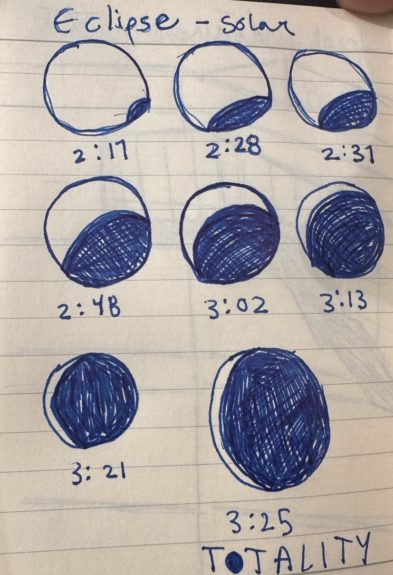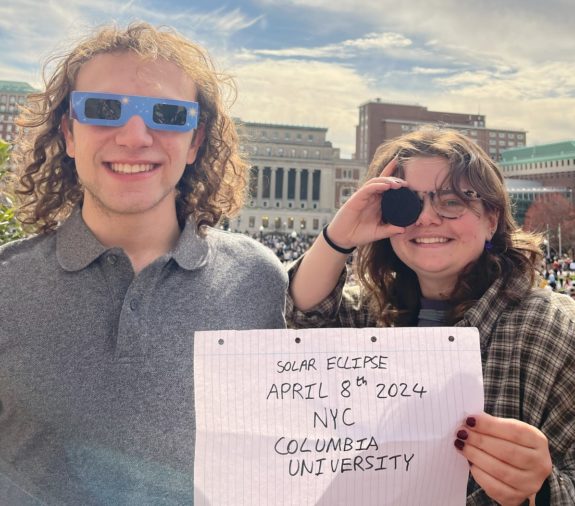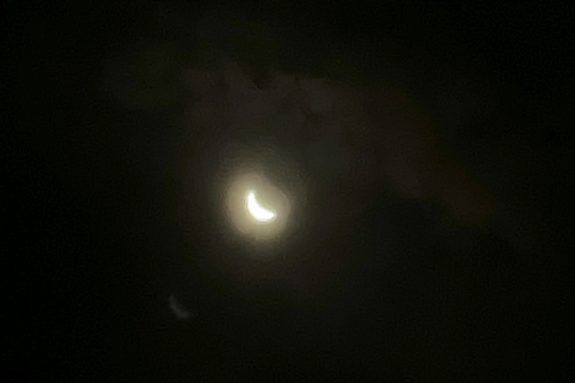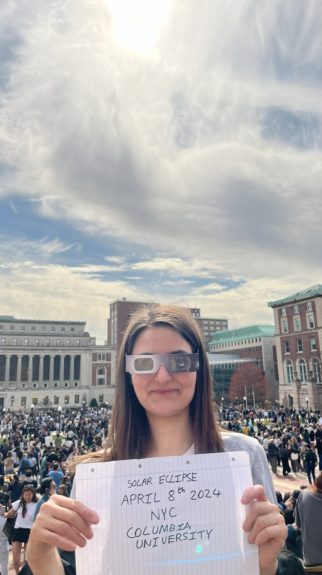Staff Writer Lilly Connolly watched the partial solar eclipse from Columbia’s campus on Monday.
When I called home a few weeks ago to let my parents know that there was going to be a total solar eclipse in the US, they were delighted, and immediately mentioned a picture they had of me as a baby next to a handwritten sign stating ‘UK total solar eclipse 1999’. For international students like myself, this Monday there was an opportunity to see something we would not get to see in decades in our home countries. A total eclipse will not happen in the UK again until I am in my nineties – the land mass is so small that it makes the chance of us being in the path of an eclipse low, and then there is the blasted cloud! I was eager to get a peek at this unique experience while here. Noticing there were only snippets about previous solar eclipses at Columbia available online it seemed like a good opportunity to record this moment as part of Columbia history and get the perspective from the people on the ground (I also promised my mother that I would get a picture for her to match with the baby photo).
Students came armed with solar eclipse glasses, cereal box pinhole cameras, and various other contraptions, ready to see this exciting event (and protect their vision while doing so). New York City was not in the path of totality (when the sun is 100% covered by the moon, and only the sun’s corona is visible), but was at 90%. Still, the next time a full solar eclipse would be visible in the United States would be in 2044, and would only be a partial eclipse of 50% in New York. The last one in New York in 2017 only had 70% coverage. This was the big event and was not to be missed.

As the partial eclipse began, I headed down to the centre of campus and asked spectators what exactly it was that they were looking forward to? Had they seen a solar eclipse before? One student I asked commented, “I feel like it’s not a once in a lifetime event, but a once in many years, and I am actually an international student so if I was back home I wouldn’t be able to see it, so I’m here for everyone back home”. There is something about these celestial phenomena that remains fascinating, even if this is not the first time we have witnessed them. Nick, a Staff member at Columbia Business School told me, “I’m looking for that once in a lifetime awe inducing experience” yet added “I saw it once in 2017 too”.
As students, staff, and the public began to crowd the lawns, some students mentioned the community atmosphere was the real highlight. Hannah said, “I am so excited for this eclipse, it’s been making my entire week, and I love seeing everyone out on the lawn together, it’s less about the eclipse and more about the shared experience, from Columbia students on a sunny day out”. Another student (who did not want to be named) told me they were looking forward to the event and joked that “Columbia should do more solar eclipses”. Students got creative – Abigail Mankin (BC ’25) even recorded the progress of the eclipse in her journal.

On the Steps of Low Library, Sydney Peet (BC ’25) and Harrison Gerson (CC ’25) were eager to see the extraordinary spectacle and were excellent company. They had even prepared by bringing themselves some food. Sydney and Harrison were kind enough to take the photo for back home. It was only after reviewing the images that we noticed an accidental (but neat) camera obscura effect on the paper! As we reached the maximum coverage of the sun in NYC, at approximately 3:25pm, some cloud drifted in front of the sun, but fortunately it was wispy enough that it did not obscure visibility of the eclipse. The light dimmed, and some of the lamps on Low steps turned on, the temperature noticeably dropped by a few degrees.

As the eclipse ended and light gradually returned to campus, spectators headed away, taking with them an unforgettable experience. Bwog hands over the torch to you, class of 2044.


Header Image via Author


 0 Comments
0 Comments